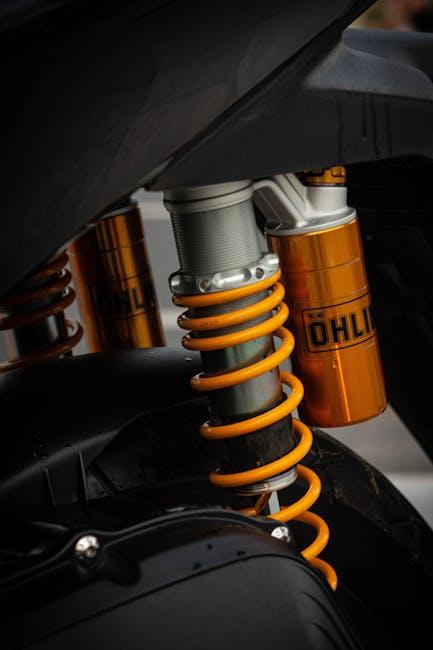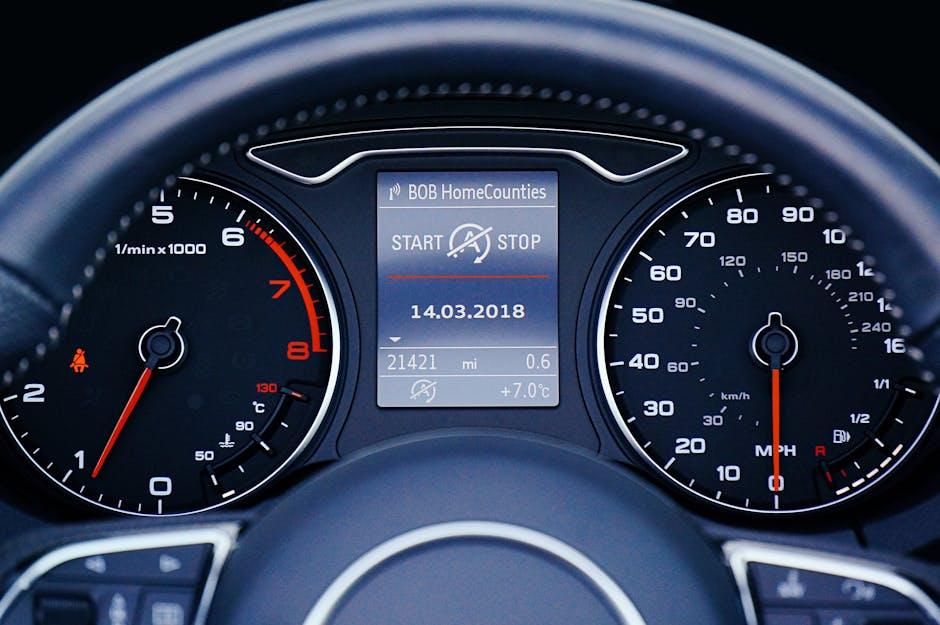There’s a unique rhythm to every car journey—the hum of the engine, the gentle sway over curves, the subtle vibrations beneath your seat. Yet, for many drivers and passengers alike, that rhythm can sometimes turn into discomfort, making even the shortest ride feel like a test of patience. Improving car ride comfort isn’t just about luxury; it’s about transforming your daily commute or weekend getaway into a smoother, more enjoyable experience. Whether you’re cruising down the highway or navigating city streets, small changes can make a big difference. In this article, we’ll explore practical tips and insights to help you create a more comfortable driving environment, turning every trip into a moment of calm amidst the motion.
Table of Contents
- Choosing the Right Suspension for a Smoother Drive
- Optimizing Tire Selection and Maintenance for Comfort
- Enhancing Seat Ergonomics and Cushioning
- Controlling Cabin Noise and Vibration Effectively
- Regulating Temperature and Air Quality for a Relaxing Environment
- Practical Tips for Minimizing Motion Sickness on the Road
- Q&A
- In Retrospect

Choosing the Right Suspension for a Smoother Drive
Selecting the right suspension system is pivotal for transforming every journey into a smooth, comfortable experience. It’s not merely about absorbing shocks, but about enhancing stability and control, allowing your car to hug the road softly yet confidently. Whether you’re cruising city streets or tackling rugged highways, understanding your vehicle’s suspension options can significantly elevate ride comfort.
Consider these factors when exploring suspension choices:
- Type of Suspension: Options like coil spring, air suspension, and leaf spring each deliver distinct levels of comfort and durability.
- Driving Environment: Urban roads demand different suspension responsiveness compared to off-road terrain.
- Load Capacity: Adjustments based on vehicle weight and common carrying needs influence suspension tuning.
| Suspension Type | Comfort Level | Best Use |
|---|---|---|
| Coil Spring | Moderate | Daily commuting, city roads |
| Air Suspension | High | Luxury vehicles, variable loads |
| Leaf Spring | Basic | Trucks, heavy-duty use |

Optimizing Tire Selection and Maintenance for Comfort
Choosing the right tires can make a dramatic difference in your vehicle’s smoothness. Opt for tires with a higher profile, as their thicker sidewalls absorb road imperfections more effectively than low-profile options. Look for tires designed specifically with comfort technology, such as those featuring silica rubber compounds or specialized tread patterns that minimize vibration and road noise. Remember, wider tires offer better grip but can transmit more road harshness; balancing width and comfort is key.
Routine tire maintenance is equally important to sustaining that plush ride experience. Regularly check and maintain the recommended tire pressure—both overinflated and underinflated tires reduce comfort by altering the suspension’s ability to cushion impacts. Additionally, timely tire rotation and wheel alignment ensure even tire wear and prevent vibrations from uneven surfaces. Below is a quick guide on optimal tire pressure ranges based on tire types:
| Tire Type | Ideal Pressure (PSI) | Comfort Benefit |
|---|---|---|
| Touring | 30-35 | Enhanced shock absorption |
| All-season | 32-36 | Balanced ride & traction |
| Performance | 35-40 | Precise handling with moderate firmness |
- Inspect tires for wear to avoid harsh rides caused by uneven tread.
- Replace old tires that have lost their elasticity and traction.
- Use tire dressings sparingly as some products can harden rubber, impacting comfort.

Enhancing Seat Ergonomics and Cushioning
Optimizing the comfort of your car seats involves paying close attention to both the ergonomics and the quality of cushioning materials. Ergonomically designed seats support the natural curve of your spine, reducing strain on your back during long drives. Features like adjustable lumbar support, seat height, and tilt can be instrumental in customizing your seating posture for maximum comfort. Additionally, incorporating memory foam or gel cushions can adapt to your body shape, distributing weight evenly and minimizing pressure points.
To elevate your seat comfort further, consider these practical enhancements:
- Add breathable seat covers: These improve ventilation and reduce heat buildup.
- Use orthopedic cushions: Specifically designed to support joints and improve circulation.
- Install seat massagers: For relaxing muscles during traffic jams or long trips.
- Ensure proper seat positioning: Align the seat to maintain a slight bend in your knees and keep feet flat on the floor.
| Seat Feature | Comfort Benefit | Maintenance Tip |
|---|---|---|
| Memory Foam Cushion | Adaptive support to reduce pressure | Regularly clean covers to prevent odor |
| Adjustable Lumbar Support | Improves spinal alignment | Check mechanisms for smooth adjustment |
| Breathable Seat Cover | Prevents overheating and sweat | Wash frequently for hygiene |

Controlling Cabin Noise and Vibration Effectively
Minimizing unwanted noise and vibrations in your car’s cabin is key to enhancing overall ride comfort. Effective soundproofing materials like acoustic foams and mass-loaded vinyl can be strategically placed in door panels, floorboards, and the roof to block external sounds. Additionally, upgrading window seals and door gaskets ensures a tighter closure, significantly reducing wind noise at higher speeds. These measures combined create a serene environment, allowing passengers to enjoy conversations, music, or simply the tranquility of the drive.
Vibration control is equally vital, as continuous jolts can cause fatigue and irritation during long journeys. Employing components such as engine mounts with advanced damping technology or adding dynamic vibration absorbers to suspension parts can drastically lessen harshness transmitted through the chassis. For quick reference, here’s a breakdown of common vibration control techniques and their impact:
| Technique | Effect on Comfort |
|---|---|
| Hydraulic Engine Mounts | Absorb engine vibrations, reducing cabin shake |
| Sound Dampening Mats | Cut down road and tire noise |
| Polyurethane Bushings | Improve suspension response and eliminate creaks |
| Window Seal Upgrades | Block air and water noise penetration |
- Regular maintenance of mounts and bushings to preserve performance
- Consider professional installation of soundproofing to maximize benefits
- Balance between noise reduction and weight to avoid impacting fuel efficiency

Regulating Temperature and Air Quality for a Relaxing Environment
Maintaining an ideal temperature inside your vehicle is a cornerstone of ride comfort. Leveraging your car’s climate control settings effectively can transform any journey into a soothing experience. Use the dual-zone climate controls if available to cater to the preferences of all passengers. Additionally, make it a habit to pre-cool or pre-heat your car before setting off, especially during extreme weather. This ensures the cabin reaches a comfortable environment right from the start, minimizing the shock of ambient temperature changes.
Air quality plays an equally important role in preserving a refreshing atmosphere inside the car. Keep your air filters clean and replace them regularly to prevent allergens and dust from circulating. Remember to ventilate the car periodically by opening windows briefly, even in colder weather, to allow fresh air exchange. Here’s a quick checklist to optimize air quality and comfort:
- Use activated carbon filters for better odor and pollutant absorption.
- Avoid idling to reduce buildup of exhaust fumes inside the car.
- Employ portable air purifiers for sensitive passengers or long trips.
- Keep the interior clean by removing trash and vacuuming regularly.

Practical Tips for Minimizing Motion Sickness on the Road
Motion sickness can turn a joyful journey into an uncomfortable ordeal. To combat this, try to keep your eyes fixed on the horizon or a distant stationary object; this helps your inner ear and eyes sync better. Often, sitting in the front seat can also reduce symptoms, as it offers a smoother ride and a better view. Fresh air plays a vital role too—slightly opening a window or using the car’s ventilation system to circulate cool air can significantly ease nausea.
Adjusting your habits before and during the trip can make a noticeable difference. Avoid heavy meals, alcohol, and excessive caffeine beforehand, as these can aggravate motion sickness. Instead, opt for light, bland snacks and stay hydrated. Comfort-minded travelers can keep a few handy items such as ginger candies, acupressure wristbands, or even mild over-the-counter remedies. Below is a quick guide on common remedies and their effectiveness:
| Remedy | Effectiveness | Usage Tips |
|---|---|---|
| Ginger Candies | Moderate | Consume before and during travel |
| Acupressure Bands | Variable | Wear snugly on wrist |
| Fresh Air | High | Open windows periodically |
| Light Snacks | High | Prefer bland, non-greasy foods |
Q&A
Q: What are the main factors that affect car ride comfort?
A: Several factors influence ride comfort, including the quality of the suspension system, tire condition and pressure, seat ergonomics, cabin noise levels, and temperature control. Each element plays a role in reducing vibrations, bumps, and overall stress during the drive.
Q: How can I improve suspension to enhance ride comfort?
A: Regularly check and maintain your suspension components such as shock absorbers, struts, and springs. Upgrading to softer or performance-oriented shocks tailored for comfort can smooth out rough roads. Professional alignment and balancing also reduce harsh impacts.
Q: Do tires really make a difference in ride comfort?
A: Absolutely. The type, size, and pressure of your tires greatly affect how your car absorbs road imperfections. Choosing tires with higher profiles or comfort-oriented sidewalls and maintaining proper inflation levels can provide a cushier feel and reduce road noise.
Q: What role do car seats play in ride comfort, and can they be upgraded?
A: Seats are your direct connection to the vehicle, so ergonomic design and cushioning matter. Investing in seats with better lumbar support, adjustable features, or memory foam padding can significantly improve long-distance comfort. Adding seat covers or cushions designed for comfort can also be a simple upgrade.
Q: How important is cabin noise control for a comfortable ride?
A: Noise levels inside the cabin can heighten fatigue and discomfort. Insulating doors and windows, using sound-dampening mats, and sealing gaps can reduce wind and road noise, offering a quieter, more peaceful drive.
Q: Can climate control impact my car’s comfort?
A: Yes. A well-functioning heating, ventilation, and air conditioning (HVAC) system regulates temperature and humidity, keeping the cabin pleasant in all weather. Using air filters and ensuring proper ventilation prevents stale air and enhances overall comfort.
Q: Are there any driving habits that improve ride comfort?
A: Smooth acceleration, gentle braking, and avoiding sudden maneuvers minimize jolts and vibrations. Driving at moderate speeds on smooth routes whenever possible also contributes to a more comfortable ride experience.
Q: How does regular maintenance contribute to better ride comfort?
A: Routine checks and timely repairs ensure that all car systems work optimally. This prevents unexpected issues that can lead to discomfort, such as misaligned wheels, worn-out shocks, or tire imbalances.
Q: Is investing in luxury features worthwhile for ride comfort?
A: While features like adaptive suspension, heated/ventilated seats, or advanced noise cancellation can elevate comfort, basic maintenance and thoughtful upgrades often deliver substantial improvements at a lower cost. The choice depends on personal preference and budget.
Q: Can small changes really make a noticeable difference in comfort?
A: Definitely. Sometimes, simple steps like adjusting tire pressure, adding seat cushions, or installing noise-reducing mats can transform a mediocre ride into a pleasant journey. Comfort often comes down to attention to detail and consistent care.
In Retrospect
Ultimately, transforming your daily drive into a sanctuary of comfort is within reach with just a few thoughtful adjustments. Whether it’s investing in quality seat cushions, fine-tuning your suspension, or simply curating the perfect playlist, each step contributes to a smoother, more enjoyable journey. Remember, comfort on the road isn’t just a luxury—it’s an essential part of a safer, more relaxed driving experience. So, take these tips to heart and turn every ride into a moment of calm in the midst of life’s hustle.

